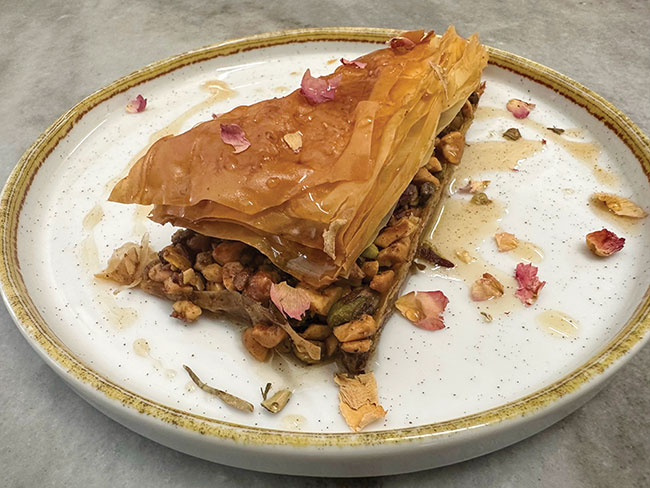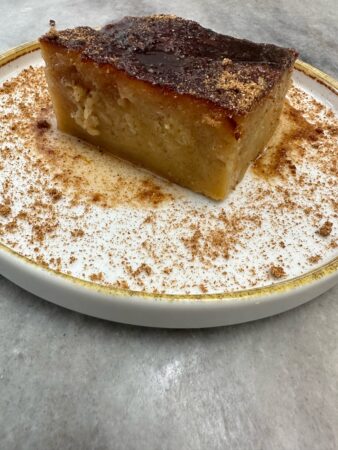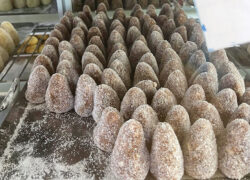
Greek delights: Exploring traditional desserts on the Cyclades Islands
January 3, 2024
By Karen Barr
 The baklava at Veneti Bakery is made with layers of tissue-paper-thin phyllo dough, brushed with ample butter resulting in a richer taste than if using olive oil. There are 12 layers of phyllo on the bottom and 12 layers on the top.
PHOTO: VENETI BAKERY
The baklava at Veneti Bakery is made with layers of tissue-paper-thin phyllo dough, brushed with ample butter resulting in a richer taste than if using olive oil. There are 12 layers of phyllo on the bottom and 12 layers on the top.
PHOTO: VENETI BAKERY Island hopping through the popular Cyclades Islands in Greece, visitors have the chance to taste traditional Greek desserts, often with a twist. Lavished with local honey, nuts, cream and spices, these desserts can easily become a sweet tooth craving.
The island of Mykonos, with just 12,500 residents, swells yearly to accommodate two million visitors. The summer party crowd, jet-setting celebrities and locals eventually visit Veneti Bakery, which opened in 1948.
“Our top sellers are the baklava and the galaktoboureko,” says shop manager Theodore Stinis. The baklava is made with layers of tissue-paper-thin phyllo dough, brushed with ample butter resulting in a richer taste than if using olive oil. “There are 12 layers of phyllo on the bottom and 12 layers on the top,” Stinis says. “We use a combination of chopped pistachios and almonds to make the filling. The syrup is made with local honey, sugar, water and lemon.”

Marzipan by Gerontopoulos Patisserie. PHOTO: GERONTOPOULOS PATISSERIE
Allowed to set, the syrup gives the pastry a condensed confection-like quality of intense sweetness. Vivid green pistachios adorn the top of each piece of baklava. Biting in reveals the spiciness of cinnamon and a hint of cloves.
Galaktoboureko is composed of a thick custard made with milk, cream, sugar, eggs, butter, semolina and vanilla. Here it is sheathed in a rectangle of butter-rich phyllo dough enhanced with honey syrup.
Warm bougatsa made with layers of phyllo topped with semolina custard, is available for breakfast each morning. Once baked, it is gently sprinkled with icing sugar and cinnamon. While it bears a similar resemblance to galaktoboureko, it lacks the sweet honey syrup.
For a perfect Greek sweet on the run, think loukoumades or Greek doughnuts. Anastasios Pyromallis is the owner of Loukoumades Naxos on the farm-rich island of Naxos. Customers line up outside the shop to watch Pyromallis make the doughnuts to order, in his tiny, open galley kitchen. There are a few high-in-demand tables out front.

Veneti Bakery’s warm bougatsa, made with layers of phyllo topped with semolina custard, is available for breakfast each morning. Once baked, it is sprinkled with icing sugar and cinnamon. PHOTO: VENETI BAKERY
Tweaking a basic doughnut dough recipe through hours of experimentation, Pyromallis found the perfect ratios of yeast, sugar, water, salt and flour. When it comes to frying the doughnuts he says, “I use the best quality oil I can find. It’s expensive, but important, as the oil is absorbed into the dough and will affect the taste.”
Traditionally, loukoumades are served hot with a drizzle of honey syrup and walnuts. “The honey syrup is my mother’s recipe,” he says. “It’s the one she uses in all her traditional Greek desserts.”
Pyromallis adds additional options such as sugar and cinnamon loukoumades or chocolate. Customers can opt for a scoop of locally made ice cream on top.
Just prior to 1950, young pastry cook Yannis Gerontopoulos left his hillside village of Apollonia, on the island of Sifnos. In Athens, he spent three decades learning his craft before returning home to open Gerontopoulos Patisserie.
Marzipan is the most traditional dessert on the tiny island. It isn’t a true celebration without it. Delightfully sweet unbaked marzipan confections, by the hundreds, line the glass showcases at Gerontopoulos Patisserie. All are handmade using fresh ground almonds, then shaped into standing, stylized oblongs and rolled in sugar.
Citrus flavours such as lemon and mandarin are popular. Each is coloured accordingly. The amaretto marzipan is darker, incorporating the skin of the almonds right into the mix. The rose water variety is especially fragrant and adds a deeper hint of romance to wedding celebrations.
The baked marzipan cookies are made without flour. They are rolled into rounds or crescents, and sprinkled with finely sliced almonds, the centres remaining soft and chewy. The cherry-flavoured marzipan contains a whole sugared cherry inside, while amaretto baked marzipan has a central almond. The crescent-shaped, orange-baked marzipan is made with the addition of grated orange rind.
Today, the business remains in the family. Daughter Anthi runs the 15-room Hotel Anthousa, above the shop. Daughter Niki oversees the pastry kitchen, while her jovial husband Theodoros manages the café serving breakfast, lunch and dinner. While Gerontopoulos Patisserie founder Yannis is not in the kitchen these days, he still works in the shop greeting customers and ringing up purchases at the cash register.

The amaretto marzipan at Gerontopoulos Patisserie is darker, incorporating the skin of the almonds right into the mix.
PHOTO: GERONTOPOULOS PATISSERIE
Residents and tourists alike cannot eat enough of the pie at the café. “Honey pie is an Aegean cheesecake prepared with honey, unsalted mizithra and eggs. No biscuits,” Niki says. Mizithra is a Greek cheese made with the milk of sheep or goat or a combination of the two. The dessert is baked into a custard-like consistency and served with an extra drizzle of honey and cinnamon. “Honey pie is usually prepared during the Easter festivities in Sifnos, but due to tourism, we make it all year.”
At Mediterraneo, a restaurant in the charming fishing village of Naoussa on the island of Paros, customers tend to linger to enjoy the view and eat something sweet. To entice customers to order from the dessert menu, French-born chef Axel Brizard, who co-owns the restaurant with Greek-born Nikoleta Parousi, says, “We have to make our desserts extra special.”
By 4 p.m., the afternoon of the interview with Bakers Journal, five men have sailed into the harbourside to recline on the restaurant terrace. They order coffee and the last pieces of baklava. “I have made more but it needs to rest overnight,” Brizard says with a shrug and a smile. “Our baklava contains three types of nuts. Fifty per cent is walnuts, while the rest is a combination of pistachios and peanuts. While the pastry is hot, I add a cold syrup made with thyme honey and water.”
Thyme honey from Greece is considered one of the best. Thyme bushes have a short blooming season from mid-May until the early summer. Thyme honey has an intense taste and a floral aroma.
On the dessert menu, customers will find traditional portokalopita, or orange cake. It combines crumbled phyllo dough, freshly squeezed orange juice, orange zest, butter and marmalade. “Traditionally, this cake contains honey syrup, but I feel it is already sweet enough. In season, I like to add fresh kumquat confit to the cake batter.”
As for pure comfort, Brizard also keeps rice pudding on his dessert menu. Unlike traditional Greek rice pudding, the chef has left cinnamon out. Instead, he combines Carolina rice with coconut milk, cream, sugar and orange zest. The combination is cooked and cooled, resulting in a rich yet refreshing dessert. Assorted chopped candied nuts add bite.
Part of the joy of visiting Greece and the Cyclades Islands is eating Greek sweets. Bakeries and restaurants keep traditions alive while offering unique twists on old classic recipes.
Karen Barr is a Canadian-based magazine journalist, copywriter and licensed chef. Helping clients unlock hidden revenue through email marketing, Karen has worked with small businesses and large national companies in the food and beverage industry.
Print this page
Leave a Reply